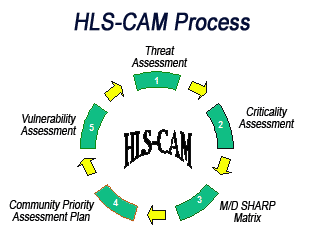HLS-CAM™ Homeland Security Comprehensive Assessment Model
The September 11th terrorist attacks and the subsequent threats and use of weapons of mass destruction against our homeland authenticated the need to reevaluate our nation's security capabilities. One area of unmistakable deficiency was a uniform method of performing threat, criticality, and vulnerability assessments.
In the past, methods of performing threat assessments, risks assessments, vulnerability assessments, security analysis, and security surveys existed, but few related to one another and definitions of each other often overlapped or were unclear. The Homeland Security Comprehensive Assessment Model (HLS-CAM™) is the first of its kind, integrating assessments and prioritizing the order in which critical facilities and infrastructure were assessed.
The NDPCI created the HLS-CAM™ after recognizing the need for federal, state, county, local and private organizations charged with protecting citizens, facilities, and infrastructure from all hazards including terrorism and hostile criminal activity, to have a uniform, comprehensive, and holistic method of performing assessments.
The NDPCI's mission is to provide homeland security solutions that protect our Nation's communities from all hazards, including terrorism and natural disaster, by providing the highest quality training, and programs, developed through participation by those on the front lines, emergency responders, who know best how to address their homeland security needs.
The HLS-CAM™ is a grass roots bottom up effort, developed by Emergency Responders for Emergency Responders.
The HLS-CAM complies with all four objectives of Homeland Security Presidential Directive 7, the National Infrastructure Protection Plan, the National Incident Management System (NIMS), and is an 'All Hazards' approach.
The HLS-CAM™ is a five part continuous process consisting of the following:
 Threat Assessment - examines and defines a community, identifies critical facilities, infrastructures and events, identifies threat groups, determines the likelihood that, given the current intelligence or designated federal, state or local threat levels, a specific target will be subject to terrorist or hostile criminal attack.
Threat Assessment - examines and defines a community, identifies critical facilities, infrastructures and events, identifies threat groups, determines the likelihood that, given the current intelligence or designated federal, state or local threat levels, a specific target will be subject to terrorist or hostile criminal attack. - Criticality Assessment - determines the overall impact of a terrorist attack on a given target and the adverse effect it has within a community.
- M/D-SHARPP Matrix - used to analyze criminal and/or terrorist targets that have been identified through the Community Threat Assessment and Criticality Assessment. The M/D-SHARPP further analyzes the targets using information obtained in the Threat Assessment and looks at the target through the threat group's perspective.
- Community Priority Assessment Plan - derived from the Criticality Assessment and the M/D-SHARPP Matrix and is used to determine the order of priority for the vulnerability assessment of critical facilities, infrastructure and events as identified during the Community Threat Assessment.
- Vulnerability Assessment - a critical on-site physical examination and thorough inspection of an assets perimeter, property within the perimeter, and building exterior and interior spaces to include all operational systems and procedures along with the security of a facility.
The National Domestic Preparedness Coalition provides training for the HLS-CAM™ methodology. The classroom sessions cover all aspects of the HLS-CAM. Students represent many disciplines and backgrounds, including all emergency response providers, security professionals and private sector representatives. The HLS-CAM™ course is a three-day course offered at a variety of locations throughout the nation. The HLS-CAM™ Training course provides the student with a working knowledge of the HLS-CAM™ process. It also provides the tools for the student to use the HLS-CAM™ model in their particular community in conjunction with their jurisdictional expertise. Classroom training includes many hands on exercises and an on-site vulnerability assessment.

